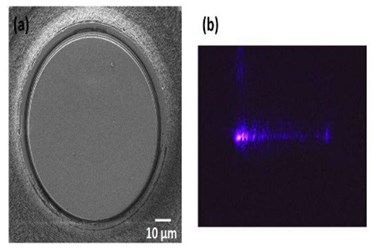Second Harmonic Generation In A High-Q Crystal Microresonator Fabricated By Femtosecond Laser

High-quality (high-Q) whispering-gallery-mode (WGM) microresonators can efficiently confine light in a very small volume via total internal reflection, leading to dramatically enhanced interaction of light with matter. The WGM microresonators have benefitted various applications including nonlinear optics, cavity quantum electrodynamics, quantum optics, and biosensing, etc. Due to high nonlinear optical coefficients, low intrinsic absorption loss, and large transparent window, crystalline resonators have recently attracted significant attention, showing promise as next generation nonlinear sources of light.
Until recently, the fabrication of high-Q LN resonator typically relies on mechanical polishing approach, which often limits the diameter of resonator to millimeter scale, and makes an obstacle for further chip-level integrated applications. Recently technical advances in the fabrication have enabled realization of high-Q on-chip sub-100 µm LN resonators with Q-factors on the order of 105~106. In particular, a study fabricated high-Q on-chip sub-millimeter LN microresonators using femtosecond laser micromachining, followed by focused ion beam (FIB) milling and high temperature annealing to improve the Q factor to be 2.5×105 [J. Lin, et al., Sci. Rep. 5, 8072 (2015)]. Recently lately, The Q-factors of the fabricated LN microresonators were improved to be 2.45×106 at wavelengths around 1550 nm by optimizing the fabrication conditions. In addition, SHG with a normalized conversion efficiency of 1.35×10-5 /mW was demonstrated in LN microresonator under CW laser pumping condition.
The freestanding LN microresonator, which is shown in Fig. 1(a), was fabricated using commercially available LN thin films. The thin film of a thickness of 0.67 µm, was bonded by a silica layer with a thickness of 2 μm on an LN substrate. The process flow of fabrication includes:(1) ablation of the sample immersed in water to form a cylindrical post using a tightly focused femtosecond laser beam, (2) smoothing the sidewall of the cylindrical post using focused ion beam (FIB) polishing with an ion beam current of 1 nA, (3) selectively removing the silica layer by chemical wet etching to form a silica pedestal for supporting the freestanding LN microdisk, and (4) postannealing (500°C for 4 h) of the sample to reduce defects generated by the FIB polishing. The Q-factor was measured to be 2.45×106.
To examine SHG in the fabricated high-Q LN microresonators, SHG experiments were carried out in the visible wavelength range using either a wavelength-tunable narrow linewidth CW laser or a broadband femtosecond laser source. The pump lasers were coupled to the microresonators via a fiber taper with a waist of ~1 µm, which was in direct contact with the sidewalls of the microresonators. An online polarization controller was used to adjust the polarization of the pump light. The generated second harmonic signals were extracted from the microresonator using the same fiber taper.
Under CW laser pumping condition, the wavelength of the pump laser was varied until the maximum second harmonic signal was generated. At a pump wavelength of 799.884 nm (the corresponding wavelength of the generated second harmonic was 399.922 nm), the conversion efficiency was found to be the highest. The normalized conversion efficiency was measured to be 1.35×10-5 /mW. Under broadband femtosecond laser source pumping condition, the center wavelength of the second harmonic light was measured to be 397.14 nm, which is exactly half of that of the resonant fundamental mode. The normalized conversion efficiency was measured to be 2.30×10-6 /mW.
In summary, this research demonstrated the fabrication of LN microresonators with Q factors as high as ~2×106 by femtosecond laser micromachining. Researchers had achieved efficient SHG in the visible wavelength of ~400 nm from the LN microresonators with either a CW or an ultrashort pulsed pump laser. The normalized conversion efficiency of SHG was measured to be 1.35×10-5 /mW when a CW wavelength-tunable laser was used as the pump.
Source: femtosecond laser
